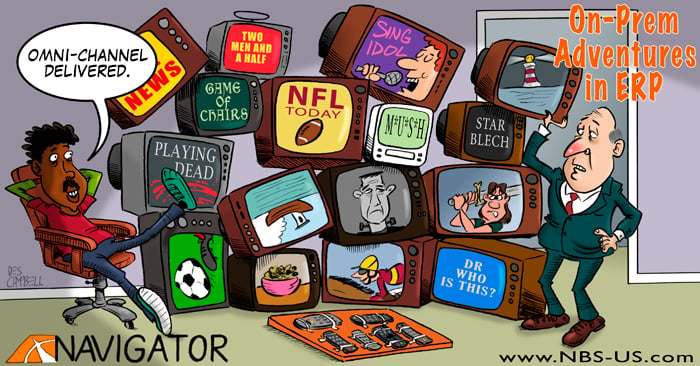
5 Benefits of Multichannel Distribution
The world of distribution is changing at a rapid pace. The mechanics between the point of sale and fulfillment to the customer are increasingly blurry. What is clear is that a multichannel distribution model is essential for success and growth.
Embracing multi-channel distribution means distributors must be agile and flexible. They need to satisfy B2B and B2C demands for omnichannel communications and buying options while also ensuring their own supply chain processes are streamlined and efficient.
U.S. inner tube distributor Countrywide Tire learned firsthand the benefits of multichannel distribution when the company modified its ERP system eight years ago. The multichannel landscape broke customizations the business had in place, and Countrywide quickly realized it needed a more advanced, cloud-based ERP solution.
Countrywide ultimately chose SAP Business ByDesign because of its scalability and broad support for custom configurations. The company estimates it saves $11,000 per year in IT costs because of the switch, and the has also greatly benefited from increased efficiency, productivity, and revenues.
While Countrywide has grown and boosted sales since its ERP upgrade, it has also scaled down from 32 to 21 employees thanks to automation and other benefits. Perhaps most importantly, Countrywide has expanded its B2B model to include direct consumer sales.
The move is vitally important in the age of multichannel distribution, and the SAP Business ByDesign was a major factor in enabling the B2C sales channel. Below we examine five of the benefits of multichannel distribution that have helped companies like Countrywide Tire to grow flexibly and efficiently.
1. Increase Customer Base and Reach More Target Market Segments
The flexibility and agility inherent in the multichannel distribution strategy enable distributors to reach a broader customer base and many more market segments.
Businesses benefit from both B2B and B2C distribution channels, enabling them to blend brick-and-mortar retail, e-commerce, and sales and marketing functionality seamlessly. Having the resources to reach a much broader range of customers (an integrated ERP system will play a valuable role in this) means businesses can easily expand into previously untapped markets.
Distributors will benefit from exposure to new customers and first-time buyers as well as having a broader geographical reach. By exploring new opportunities, they can also take advantage of channels like pop-up stores and online marketplaces to broaden their sales and marketing reach.
2. Improve Customer Interactions and Increase Availability
Customers, whether they are businesses or consumers, are increasingly demanding better and more consistent buying experiences. Omnichannel communications are in high demand, and customer satisfaction is a major competitive differentiator for any company.
Customer perception is also a critical differentiator for businesses. Companies that embrace a multichannel distribution strategy offer purchasing flexibility and convenience to their customers, which gives them an edge in increasingly competitive omnichannel distribution markets.
3. Increase Revenues
A multichannel distribution strategy will ultimately impact the bottom line of any business. Reaching a broader customer base and new markets will help boost revenue. And better serving existing and new customers through multiple, agile channels will bring in more sales.
With the help of an integrated ERP system, businesses can achieve productivity boosts and efficiencies through automation and streamlined processes. These factors, combined with increased sales and a higher rate of customer satisfaction, will ultimately boost revenue.
4. Optimize the Supply Chain
The supply chain is the backbone of any distribution business. Multichannel distribution ensures that the chain is being optimized from front-end sales through to fulfillment, and all points in between.
Amazon has taught retailers and distributors alike that the distribution pipe is still evolving and can be a murky and undefined channel. To remain competitive, distributors must recognize the importance of optimizing their supply chain, and that can only happen with a flexible, multichannel distribution strategy.
5. Multiple, Diversified Distribution Channels Reduce Risk
Relying on a single distribution channel is a major risk in today's omnichannel distribution world. By expanding distribution into multiple channels with different areas of reach and expertise, businesses can greatly reduce this risk.
Once again, an integrated ERP system will offer major benefits when it comes to successfully diversifying the distribution network. Being able to monitor, manage, and track multiple channels in real-time is critical for managing risk. An ERP system is a valuable tool for ensuring the most cost-effective and efficient channels are utilized for distributing products and services in a timely manner.
Distributors must diversify to remain competitive in today's aggressive business climate. A multichannel distribution model offers myriad benefits for organizations of all sizes. By reaching new customers, markets, and geographic regions, businesses can grow organically and cost-effectively without necessarily increasing their head count.
Finding a comprehensive ERP system and trusted partner to aid with implementation is an ideal way to pursue a multichannel distribution strategy. By taking advantage of the flexibility, automation and granular management and control ERP solutions offer, businesses can easily diversify and pursue new and exciting distribution channels.